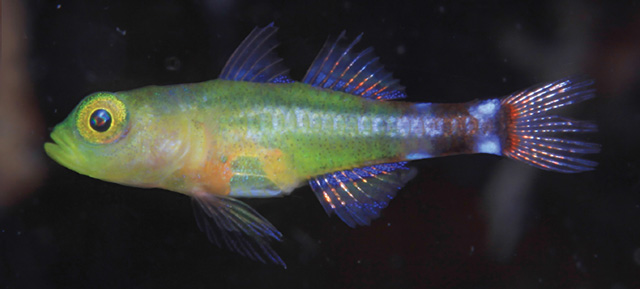| Gobiidae (Gobies), subfamily: Gobiinae |
| 1.87 cm SL (female) |
|
reef-associated; marine; depth range 45 - 70 m |
| Western Pacific: Indonesia, Papua New Guinea; photographic taken from the Philippines and Vanuatu. |
|
Dorsal spines (total): 7-7; Dorsal soft rays (total): 8-8; Anal spines: 1-1; Anal soft rays: 8-8. This species is distinguished by the following set of characters: a narrow bony interorbital (< 55% pupil width), predorsal midline with 8-9 scales; cycloid scales usually along the upper border of the opercle which may be in up to 3 horizontal rows; 2 (usually cycloid) cheek scales; a very slightly elongate second dorsal spine usually reaching posteriorly to between the base of the spine and the base of the second ray of the second dorsal fin; unbranched pectoral-fin rays; fifth pelvic-fin ray which branches once dichotomously and is 64-85% the length of the fourth ray; a full basal membrane connecting the inner margins of the fifth pelvic fins rays in undamaged specimens; black posterior half of the caudal peduncle with a large white spot dorsally and ventrally just anterior to the procurrent caudal fin rays is unique within the genus (Ref. 96671). |
| Most specimens of this 'twilight zone' species are reported from the 70 m depth range (though
have been collected as shallow as 45-55 m in the Lembeh Strait). The species do not appear to school or aggregate as with many congeners, but rather are found individually in small caves and crevices, frequently quite deep into the interstices of the reef and only visible using a strong underwater flashlight. Specimens collected were found exclusively on deep reefs sheltered from wave exposure but nonetheless exposed to currents, and although there was frequently significant silt build-up present in the caves in which they sheltered, water visibility was always good because of the significant water flow over the reefs (Ref. 96671). |
|
Least Concern (LC); Date assessed: 07 September 2021 Ref. (130435)
|
| harmless |
|
Source and more info: www.fishbase.org. For personal, classroom, and other internal use only. Not for publication.

